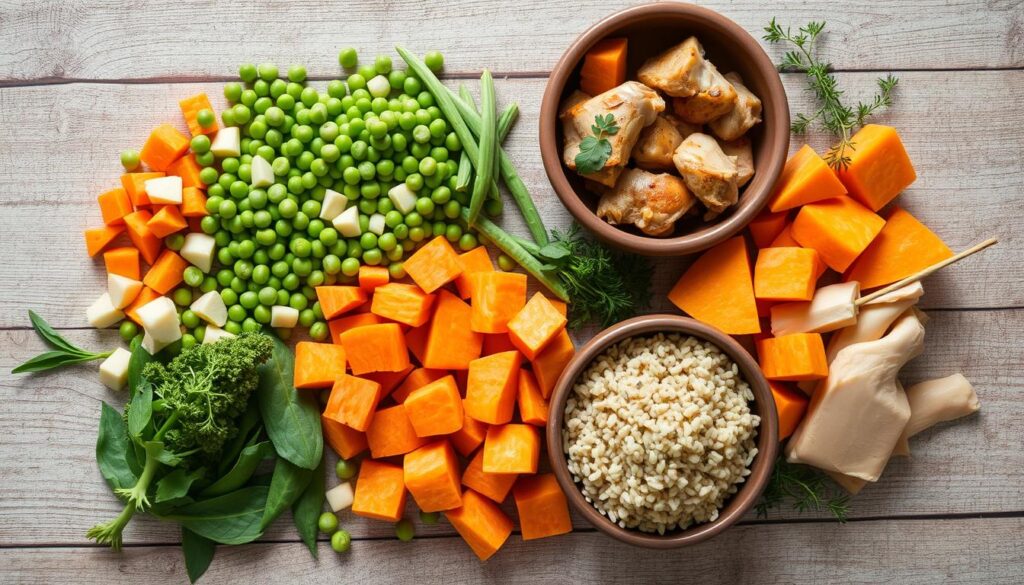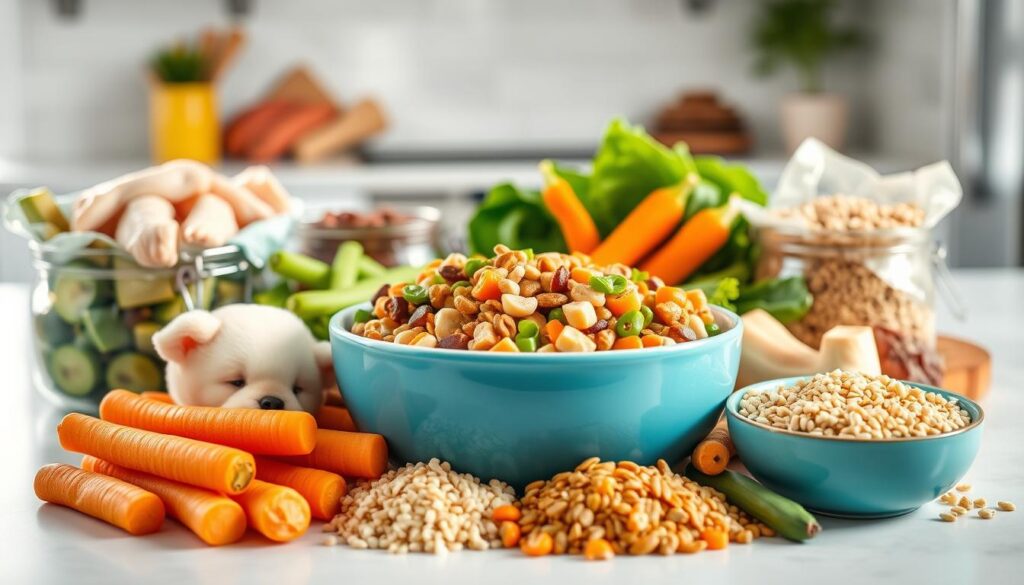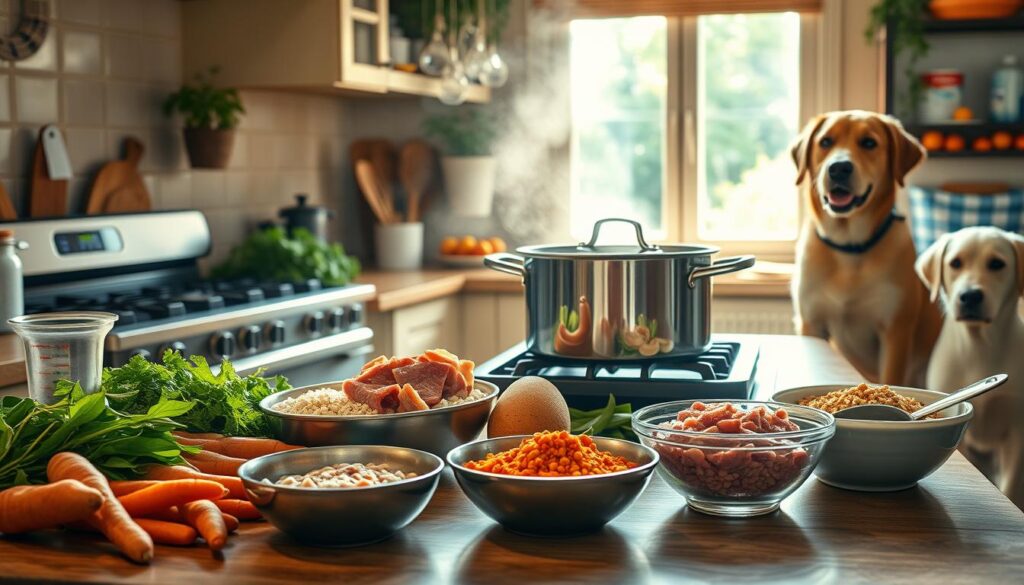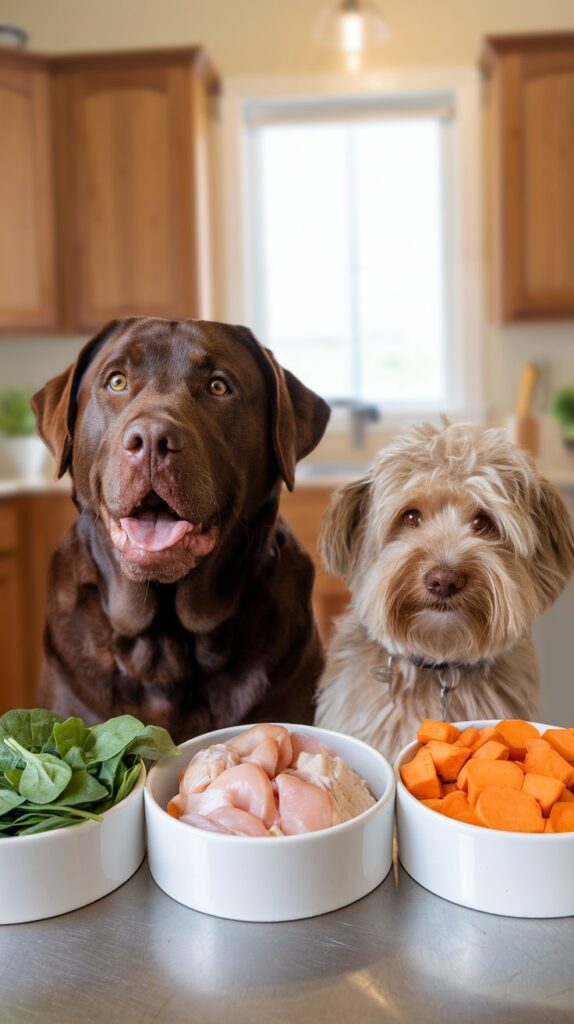
This website uses cookies to ensure you get the best experience on our website. View our Privacy Policy here.

Share this article via:
Please note: This website contains affiliate links. As an Amazon Associate, we earn from qualifying purchases at no additional cost to you.
.
As a devoted dog owner, I’ve always believed that the key to my fur baby’s well-being lies in the quality of his food. After struggling with various commercial dog food options, I discovered the transformative power of homemade meals. The journey to crafting wholesome, natural dishes for my sweet labradoodle has been nothing short of remarkable. Not only have I seen a noticeable improvement in his energy levels, allergy issues and coat condition, but the process of preparing these meals has (surprisingly!) become a genuine source of joy and pride.
In this comprehensive guide, we’ll explore the world of homemade dog meals. We’ll cover essential ingredients, cooking methods, and expert tips. Whether you’re a seasoned pet parent or a first-time dog owner, this article will provide you with the knowledge and inspiration to embark on your own DIY dog food journey. This journey will lead to a happier, healthier, and more vibrant four-legged friend.
Homemade dog food has many benefits over store-bought options. It uses natural ingredients for a healthier diet2. Dogs find homemade food tastier because it keeps the natural flavors of whole food. Also, fillers like grains and corn in commercial food are empty calories.
Homemade meals can greatly improve your dog’s health2. Now every dog will respond differently, but here are just a few of the many potential perks:
And believe it or not, homemade dog food can be as affordable as premium store brands. It may even save you money on future vet bills by having a healthier pup.
Creating healthy homemade dog food means using top-notch, natural ingredients.
Lean proteins like ground turkey, chicken, or beef are great. They give your pup the amino acids and vitamins they need3. Sweet potatoes, carrots, and zucchini add fiber, vitamins, and minerals3. Healthy fats from coconut oil or fish oil help with skin, coat, and health3.
A good homemade dog meal is about 40 to 50% protein, 25 to 30% complex carbs, and the remaining is made up of fruits, veggies and any additional supplements your doctor recommends. Eggs, fish, and some dairy are good in small amounts3.
Please…. Always talk to a vet or nutritionist before changing your dog’s diet – the ratio of proteins, carbs, and supplements can vary based on your dog’s breed, weight and age.

More pet owners are making their own dog food6. They want to know what’s in it and avoid recalls6. Homemade food is seen as healthier because it’s made from whole foods6.
Finding the right amount of food is key. A dog’s daily food should be 2-3% of their body weight6. For instance, a 15-lb dog might need 80g of chicken, 190g of rice, 15g of veggies, and 5-10g of oil each day6.
It’s important to cook dog food safely. Make sure meats are fully cooked and veggies are ready to eat6. Use methods like grilling, steaming, and boiling to keep nutrients in7.
Keeping food fresh is crucial. Refrigerated food lasts 3-4 days, while frozen lasts about two months6. Use airtight containers to store food and make prep easier8.
Always check with a vet or animal nutritionist to make sure your dog’s food is balanced7.
It’s important to feed your dog a diet rich in protein for their health. When making homemade dog food, use different high-quality proteins. This ensures your dog gets all the amino acids they need. A few examples:
PRO TIP: Always cook meat well when making protein-rich meals, unless your vet says it’s okay for raw9. Mixing different proteins makes meals tasty and nutritious for your dog.

The best mix for active dogs is 30% protein, 50% fat, and 20% carbs. For dogs prone to obesity, it’s 35% protein, 30% fat, and 35% carbs11. Talking to your vet helps make sure your dog gets what they need.
When making homemade dog food, knowing which veggies and fruits are safe is key12. Dogs can get important nutrients, fiber, and antioxidants from plants. But, some foods can be harmful or hard for them to digest. So, picking the right ones is important.
Vegetables should be cooked well to keep nutrients and make them easy to digest12. Carrots, broccoli, sweet potatoes, and spinach are great options. Cooking them softens the cell walls, making nutrients easier for your dog to get.
Many fruits are okay for dogs in small amounts, but watch the sugar12. Apples, bananas, and berries are good choices, but don’t make up more than 10% of their diet. Watch how your dog reacts to new fruits and adjust the amount.
When making homemade dog food, avoid toxic foods like grapes, onions, and garlic13. By using safe, nutritious plants, you can make tasty, balanced meals for your dog.
“Providing your dog with a well-rounded, homemade diet can have a significant positive impact on their health and well-being.”
For a complete diet, mix protein, veggies, and a balanced supplement like12 Know Better Pet Food Premix. This ensures your dog gets all the nutrients they need for health and energy.
Batch cooking is a great way to save time and make sure your dog eats the same healthy meals. Use a big pot, like a 12-quart one, to cook big batches every 2-3 weeks14. Then, freeze the meals in small containers for easy thawing and serving later14.
To mix things up, add different proteins and veggies to each batch15. Food processors can make prepping faster, saving you time14. Always cool the food down before freezing to keep it safe and fresh14.
When making homemade dog food, aim for a mix of 50% protein, 25-30% complex carbs, and the rest from fruits and veggies15. Good proteins include pork, turkey, fish, and beef. Complex carbs like quinoa, barley, and pumpkin are better than simple carbs like rice15.
| Ingredient | Percentage |
|---|---|
| Protein | 40-50% |
| Complex Carbohydrates | 25-30% |
| Fruits and Vegetables | Remaining |

Batch cooking easy dog recipes and storing them right ensures your dog gets the nutrients they need. It also saves you time and effort16. Just remember to cool the food down before freezing. Then, thaw meals in the fridge a couple of days before serving14.
When making homemade meals for your dog, it’s key to avoid certain ingredients. These can be toxic or harmful. Stay away from the following:
It’s also important to think about your dog’s allergies and sensitivities when making homemade meals17. Common allergens include beef, chicken, and grains. Introducing these without caution can cause bad reactions17. To keep your dog safe, talk to a vet or a trusted source like BalanceIT.com. They can help create a balanced diet that meets your pet’s needs18.
While a natural dog diet has many benefits, it’s important to be careful and do your research17. Consulting experts and knowing your dog’s needs can ensure a safe and healthy homemade meal18.
Making nutritious dog food at home needs the right tools. A good food processor is key for blending veggies. A large Dutch oven or pot is also needed for cooking ingredients.
Measuring ingredients accurately is crucial. You’ll need high-quality measuring cups and spoons for this. A kitchen scale helps with portioning out ingredients correctly.
After making your dog food, you’ll need to store it well. Use freezer-safe containers or silicone mold trays like Souper Cubes for this. A sharp knife set and cutting board are also useful for prepping ingredients.
With the right tools, making home cooking for dog meals is easier. This way, your dog gets a healthy, tasty diet made with care19.
| Essential Tool | Purpose |
|---|---|
| Food Processor | Blending and pureeing vegetables |
| Dutch Oven or Large Pot | Cooking protein, grains, and other ingredients |
| Measuring Cups and Spoons | Accurately portioning ingredients |
| Kitchen Scale | Precise ingredient measurements |
| Freezer-safe Containers | Storing batch-cooked meals |
| Quality Knife Set and Cutting Board | Ingredient preparation |
Homemade dog food lets owners tailor meals to their dog’s needs. This ensures the dog gets the right nutrients for its age, size, and health. Making a balanced diet at home can be tough. Often, you need to add multivitamins or nutrient mixes to cover all bases20.
Choosing high-quality, safe ingredients is key. This way, you avoid food recalls.
Dr. Bartges notes a rise in dogs eating human food due to clean eating awareness21. Homemade diets are better for dogs than commercial ones, which may have additives and gums21. It’s crucial to have a vet-nutritionist or holistic vet guide you21.
Homemade dog food is becoming more popular as a healthier option than dry kibble. It’s vital to make sure these recipes are complete and balanced. To do this, use a variety of ingredients, focus on protein, and add carbs, fats, vitamins, and minerals.
Avoid processed and seasoned foods. Portion meals based on your dog’s weight and activity level22.
IMPORTANT: Always talk to with your veterinarian before adding supplements to your dog’s diet. They can help make sure you’re feeding your fur baby the perfect portions for maximum health benefits.
Making your own dog food can be very rewarding. It often leads to better health and more energy for your dog23. Even though some recipes might not have exact measurements, with the right planning and advice from your vet, you can make a healthy diet for your dog.
Some might think it’s too much work to make dog food at home. But many pet owners find it’s worth it24. It lets you control what your dog eats, which can help with health issues and give you peace of mind.

Homemade dog food boosts a dog’s health and life. It’s packed with protein, veggies, and grains. Many dogs show better energy, coat, and less shedding after switching.
It also prevents ailments like allergies, arthritis, and obesity. This makes it a great choice for pet owners.
Homemade dog food can cost as much as premium commercial diets. It lets owners control the quality and freshness of their dog’s food. This is a big plus.
Key ingredients are lean proteins like turkey, chicken, or beef. Add veggies like sweet potatoes, carrots, and zucchini. Healthy grains are good if your dog can handle them.
Omega-3 oils and nutrient blends help ensure your dog gets all the nutrients they need.
Feed your dog 2-3% of their body weight each day. Cook food safely, making sure meats are fully cooked and veggies are ready.
Store it in the fridge for 4-5 days or freeze for 3-5 months. Use airtight containers for easy storage and batch cooking.
Try recipes like ground turkey with sweet potatoes and veggies. Or chicken and rice with carrots. Beef and quinoa with pumpkin are also good.
Fish is great for omega-3s. Eggs and liver in small amounts add nutrition.
Dogs can eat carrots, broccoli, sweet potatoes, and spinach. Apples, bananas, and berries are okay in small amounts.
Make sure veggies are pureed or cooked well. Fruit portions should be small because of sugar.
Batch cooking saves time and ensures consistent meals. Use a big pot for cooking and make meals every 2-3 weeks.
Freeze them in portions. Mix up proteins and veggies in each batch. Tools like food processors help prep ingredients fast.
Avoid chocolate, avocados, onions, garlic, grapes, raisins, and xylitol. Raw pork and salty or spicy foods are also no-go’s.
Be careful with dairy due to lactose intolerance. Watch for allergies when trying new foods.
You’ll need a food processor for veggies, a big pot for cooking, and measuring cups for portions. Meal prep containers are for storage.
A kitchen scale helps with exact measurements. Freezer-safe containers or Souper Cubes are great for storing meals.
Supplements are key for a balanced diet. Omega-3 oils are good for coat and health. Calcium might be needed without bone-in meats.
Use dog multivitamins and probiotics for extra nutrition. Always check with a vet before adding supplements.
Please note: This website contains affiliate links. As an Amazon Associate, we earn from qualifying purchases at no additional cost to you.
.
Share this article via:

This website uses cookies to ensure you get the best experience on our website. View our Privacy Policy here.